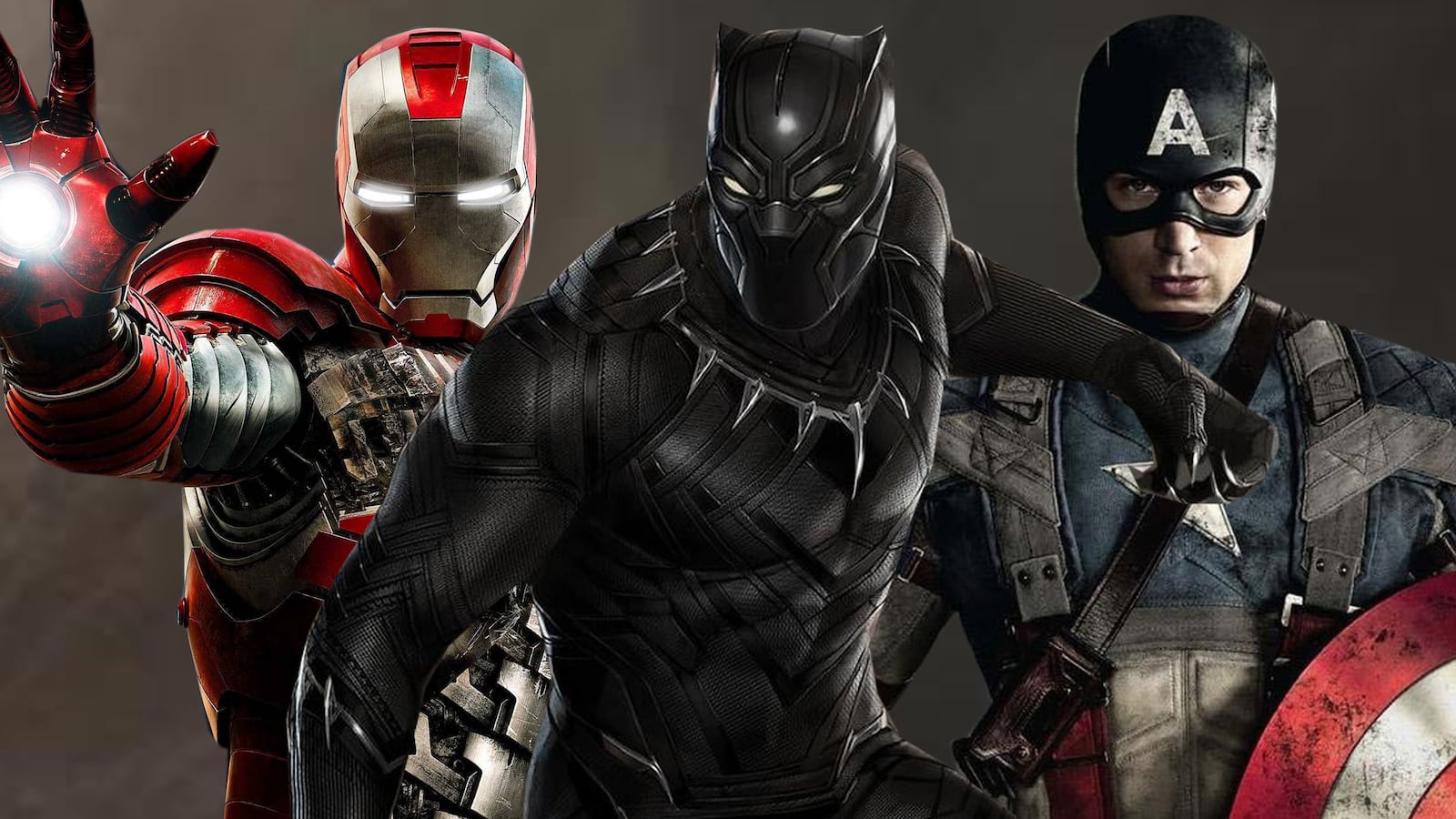The other superhero factory struck first. Last week, DC Comics undraped an impressive slate of ten films through 2020, including the long-overdue Wonder Woman, marking the first female-led superhero flick since the brutal one-two punch of Catwoman and Elektra; their version of The Avengers in all-star squad Justice League; an ethnic superhero in Aquaman, played by Game of Thrones’ Jason Momoa; and one played by an out actor in Ezra Miller’s The Flash. DC’s impressive reveal brought some much-needed diversity to the subgenre, ushering in a new era of silver screen saviors.
Like all things in Hollywood, the news came in twos. On Tuesday, in front of a packed house at Los Angeles’ El Capitan Theatre (“Captain,” get it?), Marvel President Kevin Feige unveiled his studio’s Phase 3 lineup of nine movies through 2019—those following next summer’s duo of Avengers: Age of Ultron and Ant-Man, which will close out Phase 2—and it’s a doozy.
Here they are:
· Captain America: Civil War (May 6, 2016)
· Doctor Strange (November 4, 2016)
· Guardians of the Galaxy 2 (May 5, 2017)
· Thor: Ragnarok (July 28, 2017)
· Black Panther (November 3, 2017)
· Avengers: Infinity War – Part I (May 4, 2018)
· Captain Marvel (July 6, 2018)
· Inhumans (November 2, 2018)
· Avengers: Infinity War – Part II (May 3, 2019)
While the rumored casting of Benedict Cumberbatch as Doctor Strange wasn’t confirmed, Feige did confirm that Chadwick Boseman, who played Jackie Robinson in 42 and James Brown in Get On Up, would play Black Panther, making him the first black actor top-lining a Marvel blockbuster.
“Black Panther and all of Wakanda is one of the most interesting characters in Marvel history,” said Feige. “Something I already showed you today contains an Easter egg that leads directly into ‘Black Panther.’ He’s a bit of a prince, he may even become a bit of a king, but it’s all about how this isolationist country meets the world. Maybe it goes well, maybe it doesn’t.”
Feige revealed that Black Panther will debut in Captain America: Civil War, which is based off Marvel’s seven-issue limited series Civil War, released in 2006. It centers on the U.S. government’s passing the Superhero Registration Act—an act requiring any U.S. person with superhuman powers to register with the government as “a human weapon of mass destruction,” disclose their true identity, and enter into a rigorous training program where they’ll operate as a sort of superhero police task force, helping to keep order. The act was passed due to anti-mutant hysteria in the wake of a series of superhero-related events that wreaked havoc on the general populous—in particular, a Hulk rampage in Vegas resulting in the death of 26 civilians (perhaps alluded to in the recent Age of Ultron trailer that saw Hulk clashing with Iron Man in his Hulkbuster armor).
The SRA—which many are comparing to the NSA—breaks the superheroes up into two factions: the anti-registration folks, a.k.a. Secret Avengers, who are led by Captain America and feel the act infringes on their civil liberties, and the pro-registration team, led by Iron Man (The Fantastic Four and Spider-Man are also involved, but since those properties are run by competing studios Fox and Sony, it’s fairly safe to say they won’t pop up in Marvel’s Civil War arc).
The Civil War comes to a head at “Project 42,” a prison constructed by Iron Man to house anti-registration offenders at Rikers Island. Once they’re all freed, a battle royal commences in the heart of New York City, where Captain Marvel joins the pro-registration team. It ends with Captain America sacrificing himself to end the carnage, the Mighty Avengers (led by Stark) assembling, the Avengers Initiative passing, providing a superhero team in every U.S. state, and Stark being appointed Director of S.H.I.E.L.D. The anti-registration heroes form underground group New Avengers, who convene in Doctor Strange’s Sanctum Sanctorum in Greenwich Village, while Mister Fantastic and the Invisible Woman take a leave of absence from The Fantastic Four, and are replaced by Black Panther and Storm. Captain America, meanwhile, is shot to death outside a courthouse by the villainous Crossbones and brainwashed S.H.I.E.L.D. agent Sharon Carter.
The 2016 film Captain America: Civil War will be helmed once again by the Russo Brothers, who directed Winter Soldier, and pit Chris Evans’s Captain America against Robert Downey Jr.’s Iron Man. Black Panther will also make an appearance, though it hasn’t been confirmed if Doctor Strange or Captain Marvel will pop up as well. Many are speculating that the film will mirror the comic and Captain America will die at the end of Civil War, since Evans’s contract only calls for six Marvel films total, and he’s openly discussed his desire to lay down the shield when it expires.
Which brings us to the new additions. Let’s start with Doctor Strange who is, again, rumored to be played by Benedict Cumberbatch. Doctor Stephen Strange, who debuted in 1963, is a genius, egotistical neurosurgeon—think: a medical Tony Stark—whose hands are injured in a horrific accident. As a result, they shake like crazy, and he can no longer perform surgery. So, after a bout of homelessness and a stint as a back-alley doctor, he travels to the Himalayas (a la Batman Begins) and learns the mystic arts from the Earth’s Sorcerer Supreme, its protector against dark magic. He eventually assumes the role of Sorcerer Supreme, and lives in his lab Sanctum Santorum, a Greenwich Village townhouse, where his manservant Wong, a kung fu magician, assists him. The series was popular among hippie college kids in the ‘60s and ‘70s for its psychedelic imagery, exotic landscapes, and mysticism. And, as stated previously, following the events of Civil War, Strange’s townhouse serves as home base to the New Avengers.
Along with Dr. Strange, Black Panther is a member of the Illuminati—a group of superheroes formed by Tony Stark with the mission of creating a superhero government. Black Panther’s first appearance came in July 1966 in Fantastic Four, predating the Black Panther Party, which formed three months later. Otherwise known as T’Challa, he’s the first black comic book superhero, and is chief of the Black Panther tribe in the African nation of Wakanda. His connection to the Wakandan Panther God has given him superhuman speed, strength, and agility, and an unsurpassed sense of smell. In addition to venturing to the American South and kicking the crap out of Ku Klux Klan members, he joins the Avengers in battling the Sons of the Serpent—a group of racist “patriots” who hate any and all minorities. In the Civil War storyline, Black Panther moves to New York and joins Captain America and his anti-registration Secret Avengers in the battle against Iron Man and the pro-registration superheroes.
Infinity War was a six-issue Marvel series published back in 1992. It centered on the Magus, the sworn enemy of Warlock, who has taken control of five of the all-powerful Infinity Stones and created an army of superhero doppelgangers (Hawk-Eye, Iron Man, etc.) who wreak havoc on the Avengers, and cause infighting between them. The Infinity Stones are six magical stones that, when inserted into the Infinity Gauntlet, grant the wearer infinite power. We’ve seen three of these Infinity Stones pop up in the Marvel Cinematic Universe before—the Tesseract (Avengers, others), the Aether (Thor: The Dark World), and the Power Orb (Guardians of the Galaxy). Eventually, the Avengers team up with Thanos to do battle with the Magus. In the Avengers films, however, it would make more sense to just have Thanos be the outright villain, assuming the role occupied by the Magus in the comics. So far, we’ve only been privy to a brief scene of Thanos, played by Josh Brolin conversing with Ronan the Accuser in Guardians of the Galaxy.
In addition to being the first female in the Marvel Cinematic Universe, Captain Marvel—not to be confused with DC Comics’ other Captain Marvel, who changed his name to “Shazam” when DC sold the rights over in the ‘60s—made his debut in 1967 as Captain Mar-Vell, an alien military officer from Kree who squares off against Thanos. Captain Marvel has gone through many gender iterations, but one worth nothing is in the Age of Ultron comic book arc, where the Wasp becomes Captain Marvel following the death of Hank Pym, a.k.a. Ant-Man, at the hands of Ultron.
“This Captain Marvel’s name is Carol Danvers,” said Feige at the Phase 3 event. “This film has been in the works almost as long as Doctor Strange or Guardians of the Galaxy before it came out, and one of the key things was figuring out what we wanted to do with it. Her adventures are very earthbound, but her powers are based in the cosmic realm.”
Now, Carol Danvers debuted in 1968 as Ms. Marvel, an Air Force officer who crosses paths with Captain Marvel. Following the explosion of a Kree device that claims her and Captain Marvel as victims, her genes meld with his, creating a human-Kree hybrid blessed with superpowers including flight, the ability to shoot energy out of her fingertips, and the ability to absorb energy (including, apparently, a nuclear blast). In the comics, Danvers didn’t assume the guise of Captain Marvel until 2012, joining up with the Avengers (and later, the Guardians of the Galaxy). And as previously mentioned, she joins forces with Iron Man and the pro-registration heroes during the Civil War storyline.
Last but not least, the Inhumans are a genetically advanced “inhuman race” that was formed via experimentation by the alien Kree. They occupy the city of Attilan, and consist of their king, Black Bolt, as well as the rest of his Royal Family, including Medusa, Karnak, Gorgon, Triton, Crystal, Maximus the Mad, and Lockjaw, a feisty canine. Crystal is a onetime member of the Avengers, and in various storylines is also married to Quicksilver.
Where the Inhumans will factor in to the Infinity War storyline isn’t clear, although in the Infinity comics, released in 2013 and set shortly after the events of the Age of Ultron, the earth has proven vulnerable to all sorts of alien attacks. Their biggest threat is the Builders, an ancient race of aliens hell-bent on annihilating the human race. While the Avengers do battle with the Builders in outer space, Thanos destroys earth, and attacks the Inhumans’ city of Attilan.
However this all plays out, one thing is abundantly clear: Marvel has plenty to mine from, and these incestuous superhero films aren’t stopping anytime soon.





